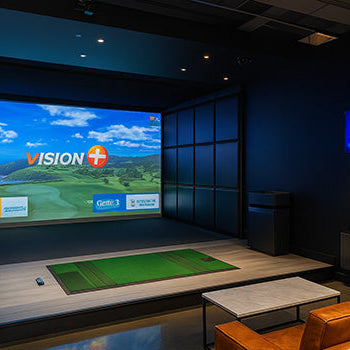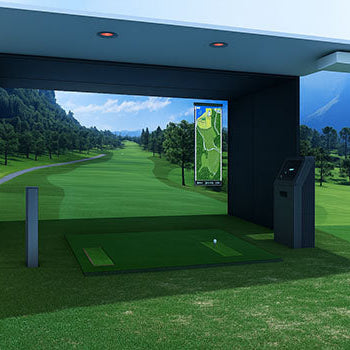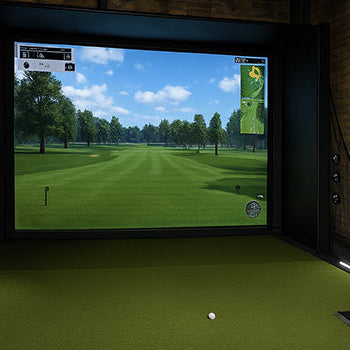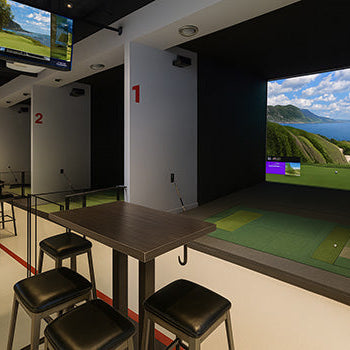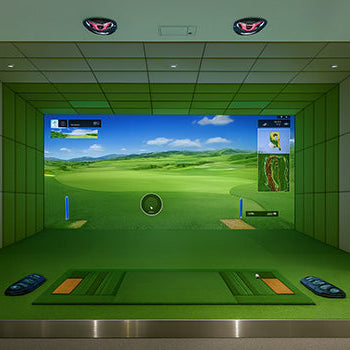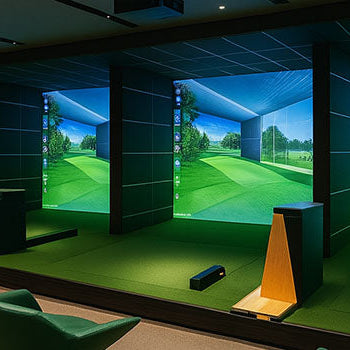Ever stripe one straight in a Golf Simulator only to watch it veer wildly like it hit an invisible gust? Short answer: align your body to the virtual target line, use the HUD for aim, and adjust for wind and elevation. This guide breaks down the exact steps, tools, and common mistakes so you can aim with confidence, every time.

Understanding the On-Screen Display (HUD)
Your simulator's HUD is more than just a fancy interface, it’s your aim assistant, weather forecaster, and GPS all in one. Mastering it is essential if you want accurate shots, especially in more advanced simulators like SkyTrak, TrackMan, or Foresight Sports.
Finding Your Target Line or Aiming Reticle
Most golf simulators use a visual aiming line or reticle. This line shows where your ball should go if you make a clean, centered swing. It’s usually color-coded or marked on-screen and can be adjusted using your controller or keyboard.
The mistake? Many players forget to realign it after each shot. Always confirm your reticle is pointing where you actually want the ball to land.
The Overhead Map: Your Strategic View of the Hole
The overhead map gives you a top-down view of the course. It shows bunkers, water, trees, and slope, all the stuff you’d normally walk or drive a cart to inspect.
If you’re not using this map before you aim, you’re playing blind. It’s the fastest way to pick a smarter target, especially on doglegs or blind approach shots.
Wind and Elevation Data: Factoring in the Conditions
Just because you're indoors doesn’t mean you're off the hook. Simulators replicate wind speed, direction, and elevation changes. You’ll often see wind arrows and slope indicators near the HUD or map.
A 10 mph wind or 15-foot downhill drop can change everything. Always read the data before setting your aim. It’s easy to forget when you’re standing in a wind-free room.
The Step-by-Step Process for Aiming Your Shot
Aiming isn’t a guess-and-swing process. It’s methodical, and once you get the routine down, your accuracy skyrockets.
Step 1: Assess the Lie and Distance
Before you even touch the aim controls, look at your current lie. Fairway? Rough? Bunker? Your lie affects launch, spin, and shot shape. Then check your distance to the pin or target landing area.
This step determines your club and how aggressively you should aim.
Step 2: Use the Controls to Move Your Aiming Point
Using the simulator interface (mouse, touchscreen, remote), move your reticle or target marker toward your desired landing zone.
Don’t automatically aim at the flag. If there’s a bunker guarding it or a slope behind it, aim for a safer spot. Strategic aiming beats aggressive aiming in most cases.
Step 3: Adjust for Wind and Elevation Changes
After setting your aim point, adjust it again based on wind and elevation. If there's a strong left-to-right wind, shift your target line into the wind to compensate. Hitting downhill? Club down. Uphill? Club up.
This is where the simulator’s feedback tools shine. Make it a habit to read and adjust before every swing.
Step 4: Align Your Feet and Body to the On-Screen Target Line
This is where simulator golf trips up even experienced players. Your body needs to be aligned with the digital target line, not the screen’s center.
Line up your feet, hips, and shoulders to match your aim. A good trick is to lay down an alignment stick on your mat to match the simulator’s projected path.

The Most Important Skill: Aligning Your Body to the Virtual Target
It’s easy to forget your physical body is still operating in the real world, even if your course is digital.
The Challenge: Your Body Is in the Real World, the Target Is Virtual
In outdoor golf, you can look downrange at the fairway. In a simulator, your only view is a flat screen. This disconnect causes alignment issues.
That’s why you might feel like you’re aiming right, but your shot starts left. You have to train yourself to trust the virtual line.
Using a Physical Alignment Stick on the Mat
One of the simplest tools? A plain alignment stick. Place it on your mat parallel to the virtual target line. It gives your feet a real-world reference point to match the simulator’s aim.
This bridges the gap between digital precision and physical movement.
How to Trust the On-Screen Line, Not Just the Screen Itself
Don’t make the rookie mistake of aiming at the middle of the screen every time. The screen is fixed, the target line moves. Find a point on your mat or wall that aligns with the simulator’s projected aim line and use that as your reference.
Over time, your body and brain will sync with the simulator’s feedback.
Advanced Aiming Techniques
Once you’re comfortable with the basics, you can start fine-tuning your aiming for shot shape, strategy, and scoring.
Playing for Shape: Aiming for a Draw or a Fade
Aiming for a draw or fade in a simulator requires precise adjustments. You’ll need to aim your reticle opposite the curve direction and manipulate your club path accordingly.
For example, for a draw, aim right of the target, then swing inside-out. The simulator will confirm your spin, club path, and shot shape post-shot.
"Target Lock" and Other Software Features
Some simulators have a “target lock” option. This lets you fix your aiming point while you focus on adjusting stance or swing without messing up your line.
Explore software features like shot replay, ball flight tracking, and trajectory overlays. These help you make smarter aiming decisions with each swing.
Using the Mini-Map to Plan Your Next Two Shots
Most players only plan for the current shot. But smart golfers use the mini-map to prep their second shot too.
If you’re on a par 5, don’t just blast it. Look where a 200-yard layup would put you. Planning two shots ahead improves scoring and reduces risk.

Common Aiming Mistakes to Avoid
Here are the big ones, if you avoid these, you’re already ahead of the curve.
Forgetting to Adjust for Wind
This one happens all the time. You get caught up in setup, forget the 15 mph headwind, and end up 30 yards short. Check wind before every shot, make it part of your pre-shot routine.
Aiming Your Body at the Screen Instead of the Target Line
Your eyes want to aim straight at the screen. But if your virtual target is left of center, that alignment is way off. Always match your body to the on-screen target line, not the screen’s center.
Not Using the Overhead Map for Course Strategy
You wouldn’t tee off on a real course without looking at the layout, right? Same logic applies here. Use the map, it’s the key to smarter aim, safer plays, and lower scores.
Final tip? Practice like it’s real golf. Use drills, alignment sticks, and consistent routines to build muscle memory in the simulator. Do that, and your on-course performance will improve right alongside your virtual game.
